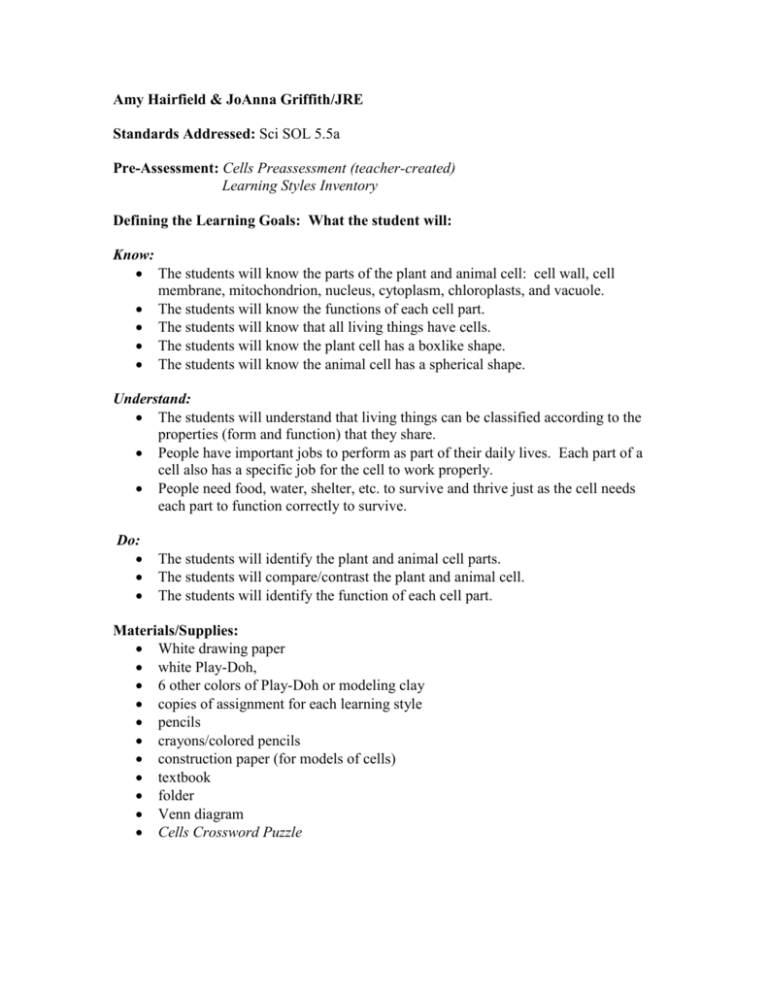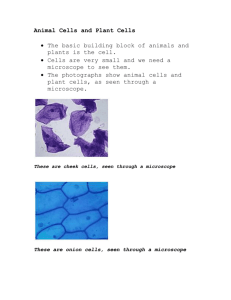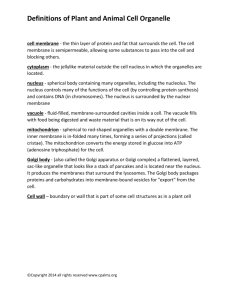Grade Level/Subject/Topic: Date
advertisement

Amy Hairfield & JoAnna Griffith/JRE Standards Addressed: Sci SOL 5.5a Pre-Assessment: Cells Preassessment (teacher-created) Learning Styles Inventory Defining the Learning Goals: What the student will: Know: The students will know the parts of the plant and animal cell: cell wall, cell membrane, mitochondrion, nucleus, cytoplasm, chloroplasts, and vacuole. The students will know the functions of each cell part. The students will know that all living things have cells. The students will know the plant cell has a boxlike shape. The students will know the animal cell has a spherical shape. Understand: The students will understand that living things can be classified according to the properties (form and function) that they share. People have important jobs to perform as part of their daily lives. Each part of a cell also has a specific job for the cell to work properly. People need food, water, shelter, etc. to survive and thrive just as the cell needs each part to function correctly to survive. Do: The students will identify the plant and animal cell parts. The students will compare/contrast the plant and animal cell. The students will identify the function of each cell part. Materials/Supplies: White drawing paper white Play-Doh, 6 other colors of Play-Doh or modeling clay copies of assignment for each learning style pencils crayons/colored pencils construction paper (for models of cells) textbook folder Venn diagram Cells Crossword Puzzle Procedures/Activities: MASTERY (ST-RECALL) TASK: Draw and label the plant and animal cells. You must include the following: a. correct shapes of the cell b. plant cell structures 1. cell wall 2. cell membrane 3. cytoplasm 4. chloroplasts 5. mitochondrion 6. vacuole 7. nucleus c. animal cell structures 1. cell membrane 2. cytoplasm 3. mitochondrion 4. vacuole 5. nucleus d. Beside each part, you should write the function (job) of each part. Ex: nucleus – control center If you get stuck, move on to the next part and come back to this one. e. Color your diagram. You may choose whatever colors you want but be sure to color the CHLOROPLASTS a certain color. (hint, hint) ANCHOR ACTIVITIES: If you finish your assignment before time is up, you may work on one of the following activities: 1. Plant and Animal Word Search (puzzlemaker.com) 2. Concentration using flash cards provided INTERPERSONAL (SF-RELATE) TASK: Sketch the plant and animal cells and label all of the parts and functions. (MUST DO THIS). Choose one structure (part) of the plant cell and name it as if it were a superhero, video game character, or cartoon character. (ex: Mikey Mitochondrion) **You may choose one of the following activities to do: a. Write a paragraph about your super hero. Your paragraph should include: 1. a description of yourself (including your new name) 2. what your special powers are (job of the cell part—ex: Mitochondrion gives the cell its energy) 3. why you feel that you are the most important part of the cell 4. what would happen to the other structures of the cell if you are destroyed **As you write your paragraph, you may use a dictionary to help you with spelling. OR b. Draw your new character and put your name at the top of the page. Your poster should include: 1. a description of yourself (including your new name) 2. what your special powers are (job of the cell part—ex: Mitochondrion gives the cell its energy) 3. why you feel that you are the most important part of the cell 4. what would happen to the cell if you are destroyed **Feel free to write “around” your character instead of paragraph form if you wish. **As you create your poster, you may use a dictionary to help you with spelling. ANCHOR ACTIVITIES: If you finish your assignment before time is up, you may work on one of the following activities: 1. Plant and Animal Word Search (puzzlemaker.com) 2. Concentration using flash cards provided UNDERSTANDING (NT-CONNECT) TASKS: 1. Compare and contrast the plant and animal cell using the Venn Diagram. Be sure to include the following terms: a. cell wall b. cell membrane c. cytoplasm d. chloroplasts e. mitochondrion f. vacuole g. nucleus Beside each structure write the function (job) of each. 2. Complete the crossword puzzle entitled Plant and Animal Cell. ANCHOR ACTIVITIES: If you finish your assignment before time is up, you may work on one of the following activities: 1. Plant and Animal Word Search (puzzlemaker.com) 2. Concentration using flash cards provided SELF-EXPRESSIVE (NF-CREATE) TASK: Create a model of the plant and animal cell. You should follow these guidelines: a. The base of the cell must be made using white Play-Doh. Be sure to shape the cell correctly. b. You may use any color you wish to create the following structures: 1. cell wall (plant cell only) 2. cell membrane 3. chloroplasts (plant cell only) 4. cytoplasm 5. mitochondrion 6. nucleus 7. vacuole c. After creating your model, you should create a key that will identify each part of your cell. (ex: yellow = mitochondrion) Your key should include all structures of the cell. d. Last, you should draw lines from each structure and write what the function (job) of that part is. ANCHOR ACTIVITIES: If you finish your assignment before time is up, you may work on one of the following activities: 1. Plant and Animal Word Search (puzzlemaker.com) 2. Concentration using flash cards provided (flash cards made on scholastic.com/homework) (If) Differentiated Instruction: What? content process product How? readiness interest learning profile Why (What prompted you to differentiate in this way)? PREASSESSMENT SOL 5.5a Name ________________________________ Date ______________________ DIRECTIONS: Answer each of the following questions to the best of your ability. 1. What are all living things made of? 2. What shape does an animal cell tend to have? 3. What shape does a plant cell tend to have? 4. How are we able to view cells? Define: 5. nucleus 6. cell wall 7. cell membrane 8. vacuole 9. chloroplasts 10. cytoplasm 11. Draw and label a plant cell and label its parts. 12. Draw and label an animal cell and label its parts.









